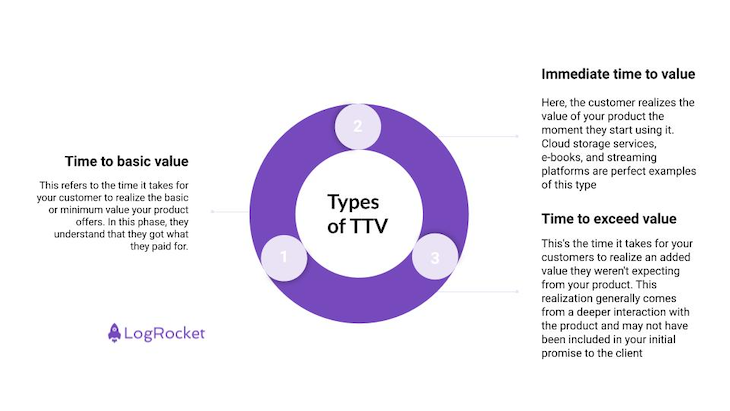Let’s imagine your product team worked hard for months to launch a product your customers have been eagerly awaiting. You invested in marketing campaigns, and onboarding went smoothly, but as soon as your customers arrive, they leave just as quickly.

You might be wondering what the problem is since you offered them exactly what they asked for. Why aren’t customers using your product?
The answer lies in time to value (TTV). Once you’ve convinced your customer to buy, you have a limited amount of time to demonstrate the value of your product.
In this article, you will learn what time to value is, why it is so important for a product’s success, and how to minimizing your time to value for better customer satisfaction.
Time to value (TTV) measures how quickly your customers expect to benefit from the value your product provides.
To put it another way, time to value is the period when your customers realize the value your product brings them.
Generally, customers want their return on investment (ROI) as soon as possible because they may have invested time, effort, and money in your product.
Thus, a lower time to value should be one of your business goals.
There are multiple types of time to value, but the top three are:

In order to demonstrate (TTV), I will share a real situation that happened earlier in my career. My company provided a specific payment card service for B2B clients. Later on, the customer service team reported that within only three months, more than 2,500 individuals requested the same service we offered only to companies.
The number of requests reached a point where we could no longer reject them. Instead, the company then decided to launch the same product (card) for individuals through a partner.
The product and marketing teams worked for five months on the project. Everything seemed smooth, including the onboarding. However, after exactly three weeks, account closing requests flooded in from every channel.
What was the problem, and where were the individuals who kept asking us for this service before the launch?
The issue was that these clients couldn’t use the product right after onboarding. Card top-up was only available through a bank transfer, so they needed to wait at least five days to use their card. We failed to grasp and discovered later on that these clients needed that specific card urgently for a particular use in two specific countries where only that card is accepted.
As a product team, we failed to understand their sense of urgency and the reason behind their request for the service.
In other words, customers were not satisfied, resulting in a product failure. This demonstrates how important time to value is in determining a product’s success. And yet, it continues to be one of the most neglected and underestimated metrics by product managers.
Measuring time to value can be tricky since you’re measuring a period of time. So, let’s break it down step by step.
First, before measuring time to value, you need to understand what “value” means to your customer. Value is the benefit your customer expects to get from your product.
The second thing you need to check is where it starts. To measure a period of time, you need to know its start and end points. So, where should you start the calculation from?
Time to value can begin at different moments depending on the buyer’s journey and your product. It could start from the moment they decide to purchase or from the moment they use the product. Below are three instances that illustrate the differences in start date:
To summarize, time to value is tied to your customers’ goals and expectations. Get close to them and understand their needs first. Whatever those needs are, the moment they are fulfilled is when they receive their value and ROI.
Although there are a number of factors that influence TTV, the two main ones are:
The onboarding process and duration have a direct impact on time to value and customer satisfaction. A lengthy onboarding process means users have to invest more time and effort before they can start experiencing the value of your product.
Some products naturally require longer onboarding processes, and some complex products even need training sessions before users can begin. This isn’t necessarily a bad thing; you should always take the necessary time to onboard your users correctly.
Personalize the onboarding experience and remove all friction points in the user journey.
If you notice that your users are taking a long time to adopt new features, there are two possibilities: either they aren’t interested in them, or there’s an obstacle preventing them from using them.
When your features are complicated, you extend the learning curve for your users. Consequently, you increase time to value because your users won’t be able to grasp the value of these features quickly.
To effectively reduce TTV, employ the following strategies:
A study conducted by Sixteen Ventures Research found that 80-90 percent of customers unsubscribing within the first three months cite lack of perceived value as a reason for leaving. Onboarding is key, especially in the SaaS environment, because it defines the success and adoption of the solution by the customer.
Onboarding must lay the foundation for your relationship with the customer and reassure them about choosing your solution beyond any promises made before onboarding. It guarantees long-term retention but, if not done effectively, can also be the starting point for future churn.
Simplify and optimize the onboarding process to get customers up and running quickly. Provide clear instructions, intuitive interfaces, and guided tutorials that help users understand and use the product efficiently.
An intuitive design takes into account users’ mental models and expectations.
Use a design that users are already familiar with to simplify the onboarding process and provide clear, consistent navigation. Intuitive design accelerates users’ ability to grasp and use your product, reducing the learning curve and facilitating quick realization of value.
When developing a product, focus on the key points that add the most value.
One of the main mistakes product managers make is trying to create too many features at once. Product managers should prioritize a few key features that provide maximum value so they can deliver them faster. This can add more value than introducing numerous complicated new features.
Analytics data reveals how your users engage with your product at each step and what problems they encounter. Collecting and analyzing data frequently helps you discover issues early before they spread to other customers, study customer satisfaction levels, and take necessary actions to correct problems.
Customer support plays a vital role in reducing time to value by providing timely assistance to users. Support teams need to be on standby to listen to customers, help them during onboarding, or troubleshoot problems as quickly as possible.
Offer your customers multiple ways to communicate with you or find solutions themselves (checking FAQs, tutorials, or other resources). By helping your customers when they need it, you ensure a smooth user experience. Efficient customer support accelerates users’ journey toward value realization, increases satisfaction, and contributes to long-term customer success.
On one hand, digital goods have the lowest time to value. Amazon understood the importance of time to value early on through e-books. When a customer purchases an e-book and can immediately download it, the value creation time is only a few seconds.
Amazon continued to create a very short time to value by delivering everything you buy in 24 hours or less, leading to the company’s growth and inclusion in the “big four” (GAFA).
On the other hand, these aren’t the only products with low time to value. One of the most amazing examples I can share is when you order groceries through an app and receive them within five minutes of clicking “purchase.” This time to value is considered very low because it takes significantly less time than going to the supermarket, finding products yourself, waiting in line to check out, and returning home.
The customer can also receive a much higher value if they urgently need those groceries. Let’s say a customer forgot an important ingredient and was reminded of it in the middle of cooking. Imagine how satisfied and happy they would be by getting it delivered to their door in just five minutes.
Time to value may seem complex at first, but if you look closely, it’s essentially about putting yourself in your customers’ shoes.
A well-executed onboarding process serves as a strong foundation. Strengthen this by offering the best assistance and support to your customers.
More importantly, work on getting to know your customers better to find out what their needs are, what problems they face, and what they expect from your product. Your customers’ feedback is the answer to everything.
Once you grasp the fundamentals, adopting appropriate strategies to minimize this metric becomes manageable. By focusing on reducing time to value, you can improve customer satisfaction, increase retention rates, and ultimately contribute to the success of your product.
Featured image source: IconScout

LogRocket identifies friction points in the user experience so you can make informed decisions about product and design changes that must happen to hit your goals.
With LogRocket, you can understand the scope of the issues affecting your product and prioritize the changes that need to be made. LogRocket simplifies workflows by allowing Engineering, Product, UX, and Design teams to work from the same data as you, eliminating any confusion about what needs to be done.
Get your teams on the same page — try LogRocket today.

A practical five minute revenue estimation method to help product managers compare ideas, drop low impact features, and prioritize smarter.

A practical guide for PMs who want to stop being bottlenecks, delegate smarter, and lead teams effectively with a clear ownership framework.

Stop letting unreliable data block features. Treat data as inventory to track quality, ownership, and ship with confidence.

Learn why slide decks slow teams down and explore better tools like whiteboards, PRDs, and prototypes to improve collaboration and alignment.